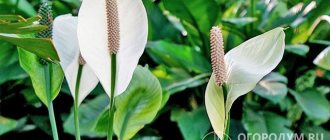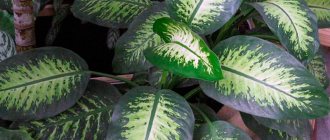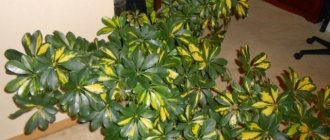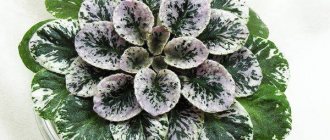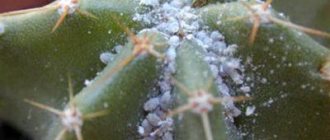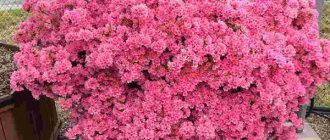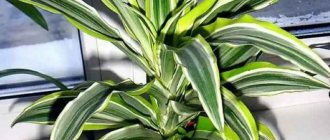When the discoverers, setting foot on the American coast, saw giant trees with slits in their leaves, they called the discovery “monsters.” Foreigners experienced particular fear when observing such a characteristic monstera phenomenon as aerial roots. Forming along the entire length of the trunk, the root, having reached the ground, took root there to continue development. Some roots appeared at great heights and continued to develop, reaching any support that stood in their way. Almost the same thing happens in the apartment.
What does a monstera look like?
The monstera plant is native to the tropical forests of South and Central America. In its natural environment, it can grow up to 50 m in length. At home, the largest specimens do not exceed 6 m.
The leaves of the vine are leathery and grow on large petioles. The characteristic color is dark green. But there are also variegated varieties.
The young monstera has solid leaf blades. Over time, holes appear on them. An adult leaf takes on a characteristic carved shape.
The largest leaves reach 1 m in length and half a meter in width.
Monstera produces 2-3 leaves per year. When young leaves reach a certain size, the growth of the vine stops and the formation of aerial horses begins.
After this, the plant produces a few more leaves, then slows growth again to gain mass of aerial roots.
When to replant monstera
Considering the age of the indoor flower, transplantation is carried out differently at young, middle and mature ages. In the first three years of life, the monstera needs to be replanted every year in early spring, increasing the size of the flower container. In the next three years, when the growth and development of the plant becomes more active, two to four transplants will be required each year. In subsequent years, when the crop reaches a large size, replanting may not be necessary. Instead, it is recommended to replace the top layer of soil with a new fertile soil mixture.
What types of monstera are popular?
In total there are over 50 species of this vine.
Monstera Deliciosa, Delicious or Attractive (Monstera deliciosa) at home grows no longer than 3 meters. The leaves are dark green and resemble elongated hearts.
Monstera Adansonii (Monstera adansonii) or Perforated can grow up to 8 m. The leaves are shaped like an egg. The plates are dotted with small holes.
Monstera Obliqae or Monstera Obliqae is characterized by small (no more than 20 cm in length) leaves. The plates are oval-shaped, asymmetrical.
Monstera friedrichsthalii is sometimes classified as a separate species. But more often it is called a subspecies of Monstera Adanson or Monstera Oblique. Outwardly, it looks more like the first one.
Thanks to the efforts of breeders, variegated (variegated) varieties of monstera have been developed:
- Monstera Alba is distinguished by white spots on the leaves and stem; they can occupy up to half the area of the leaf plate;
- Monstera Marble combines yellow and green colors;
- Monstera Borziga has smaller leaves (about 30 cm), another difference from Monstera Deliciosa is thinner stems.
Monstera Minima has a sparse crown and is well suited for growing as an hanging plant.
One of the rarest varieties is the thin monstera (Monstera tenuis). A distinctive feature is that the leaves on one plant differ not only in length and width, but also in shape.
The Monkey Leaf variety has elongated leaves. They are not dissected, but have wide slits.
Photos and names of other interesting monstera species can be seen in the video below.
Features of growing monstera at home
All indoor plants have their own growing characteristics, and Monstera is no exception in this regard (that is, caring for the plant and its cultivation must be carried out in accordance with established requirements). At home, they often grow delicious or attractive Monstera.
Choosing a location for successful growth
The best place to plant a plant such as monstera is a special stand. It should be located on the western or eastern side of the window.
However, it is worth protecting the flower from drafts so as not to provoke the appearance of diseases. Also, you should not frequently move it from place to place. Monstera does not really like direct exposure to sunlight, so it should not be placed on an overly lit windowsill: the lighting should be average. The sun can burn the flower, which leads to the formation of dark spots, and as a result, the death of the plant.
Requirements for soil and container for planting
For normal flower development, it is necessary to pay attention to the soil. Most often, it is bought in a store, but you can cook it yourself.
Soil for monstera must contain the following components:
- turf land;
- peat;
- humus;
- leaf soil;
- sand.
All these components should be taken in the proportion 3:1:1:1:1. Such soil will absorb water well and allow air to pass through. When choosing a pot for planting a flower, you need to take into account the maximum parameters of the future plant. In a large pot, Monstera will quickly strengthen the root system and begin to develop soon, but as soon as the plant reaches a large size, the roots begin to curl and wrap around in a circle. To prevent the monstera from strangling itself, during the process of replanting it is necessary to untangle and trim off excess roots. If this is not done, the flower may dry out.
It is better to take a pot larger than the previous one by 2-4 cm in diameter.
It must be stable and heavy.
Important!
To support the monstera, you should use special tubes that are covered with artificial moss. This way they will not disturb the decorative appearance of the plant.
How to care for monstera
The house flower Monstera is loved for its unpretentiousness. The plant is easily satisfied even with artificial light and does not require extreme wintering conditions.
Lighting
For monstera, prolonged exposure to direct sunlight and deep shade are equally destructive.
The best lighting for her is bright diffused light or partial shade. The optimal length of daylight is 12 hours.
For this vine there is no difference between natural and artificial lighting. It grows well under lamps.
A signal that the monstera does not have enough light will be smaller leaves without openwork cuts.
Signs of sunburn are pale leaves covered with yellow spots.
Location
Monstera is placed not on the windowsill, but on a stand. The flower is placed near windows facing west or east. If the windows face south, it is better to move the pot deeper into the room.
Monstera does not tolerate frequent movements.
Therefore, it is recommended to think in advance about a place where the overgrown vine will not interfere. They also take into account that over time it will need supports.
The flower should not be placed where it will be exposed to cold air from an air conditioner or from a window when ventilating. In addition, it should not be located close to the radiator or heaters.
Temperature
Like all indoor flowers, monstera does not tolerate drafts and sudden changes in temperature.
Monstera prefers moderate temperatures:
- 20-25°C in summer;
- 18-20°C in winter.
At temperatures below 15°C the vine stops growing, below 10°C it dies.
The hotter the room, the faster the monstera grows.
But to prevent it from suffering from overheating, you will need to increase the humidity.
Monstera does not have a pronounced dormant period. But it is recommended to let it rest at a low temperature for at least a month.
Humidity and spraying
For health, Monstera requires a humidity of more than 60%. It is supported by spraying the air or the plant itself.
It is recommended to do this on average once every 2 days. If the temperature exceeds 26°C - every day. If the room is colder than 16°C, spraying is stopped.
For the procedure, water at room temperature that has been standing for at least 24 hours is used.
"Polishing"
In addition to spraying, monstera requires regular wiping with a damp cloth.
The dust that collects on the leaves harms the plant and closes the pores, forming a film.
It is not possible to remove dust only by spraying. If you limit yourself to this procedure, unsightly stains will remain on the plates.
To keep the leaves glossy, wipe them once every 1-2 weeks. For this you can use:
- aerosol formulations from flower shops, such as Bona Forte leaf gloss;
- weak vinegar solution;
- milk diluted with water;
- a mixture of water and lemon juice.
Only mature leaves are wiped. They act without pressure, moving the napkin from the petiole to the tip of the leaf. First, use a cloth soaked in clean water, then in a “polishing” compound.
Watering
Monstera is watered with settled warm water. Do not allow liquid to stagnate in the pan.
In summer, watering should be plentiful. The frequency is determined by the top layer of soil. As soon as it dries, the plant is immediately watered.
In winter, wait until the soil dries out by ¼ of the pot. This requires less water at a time.
A sign of insufficient watering is lost moisture, wrinkled leaves.
If the plant is flooded, this will lead to rotting of the roots and the appearance of fungus on the trunk.
Feeding and fertilizers
As a fertilizer for monstera, liquid formulations or granules intended for any decorative foliage plants are used. She has no special requirements for the composition of the fertilizer.
Recommended drugs are shown in the table.
| Brand | Compound | The main task | Photo |
| Bona Forte (Red) | N:P:K:Mg - 5:3:4:1 Succinic acid Microelements Vitamins | Stimulates growth Brightens foliage Increases immunity | |
| Bona Forte (Blue) | N:P:K - 5:3:4 Humate 0.5% 9 microelements | Prevents leaf shedding Protects against yellowing | |
| Good power | N:P:K - 5:2.5:3 Humate 0.3% B1, PP Succinic acid | Activates growth Increases immunity | |
| ETISSO | N:P:K - 7.1:3.1:4.2 | Activates growth Adds brightness to foliage |
Monstera is fed only from the end of March to the beginning of September. This should be done once every 2-3 weeks.
Expert advice: “Monstera only needs half the dose recommended by the manufacturer. Especially if the flower grows in partial shade.”
Some gardeners use “folk” remedies as fertilizers for Monstera:
- mullein infusion (once a year, in summer);
- infusion of banana peel with the addition of crushed eggshells and magnesium sulfate;
- sugar dissolved in water.
A sign that Monstera lacks nutrients is that the leaf blades turn yellow and dry out.
You can learn more about caring for Monstera from the video.
Garter and supports
Supports begin to be used when the monstera becomes taller than 50 cm. If they are not provided, the plant will break under the weight of its leaves.
For young specimens, sticks wrapped in coconut fiber are used. For larger ones, use a wooden lattice attached to the wall, or tie it directly to the furniture.
Expert advice: “Cover the monstera support with moss and moisten it regularly.”
You can make a support for a short monstera yourself using the following instructions:
- Take a stick or plastic tube with a diameter of 2-3 cm.
- Tie sphagnum moss to it with twine.
- Wrap it in large mesh plastic mesh and secure it with fishing line.
- Place the support in the center of the monstera pot.
- Tie the trunk to the support in several places using twine. Do not tighten it too tightly.
- Secure aerial roots to the mesh.
This support is installed when replanting a plant.
You can see how the monstera is tied in the video.
Pruning and rejuvenation
Monstera does not require formative pruning. Only dried leaves are removed as they die.
Rejuvenation is resorted to if the monstera has slowed down its growth and dropped its lower leaves. The procedure is carried out in the spring, immediately after the end of the rest period.
The top of the plant with 2-3 nodes is cut off. This should stimulate the side buds.
The cut site is sprinkled with crushed coal, and the resulting cutting is used for propagation.
How to plant a monstera at home: propagation of a tropical liana
In order for the monstera to grow well and develop, it needs to be provided with proper planting and care. Place drainage 5 cm thick at the bottom of the pot, then fill the container with soil to ½ of its volume, then carefully place the plant without damaging its root system, and fill it with the remaining soil. At the end of planting, the flower is watered well.
Monstera can and should be propagated, and the methods of its propagation are listed below.
Method 1. Monstera propagation by air layering
Each cutting must contain at least one aerial root and one leaf. The cuttings are moved to a separate container with a nutrient substrate, thoroughly watered and grown separately. Young cuttings are grown in the same way as the monstera itself at a temperature of +18...+20°C, in diffused light and in a draft-free room.
Method 2. Propagation by cuttings
This method is the most labor-intensive.
To achieve a good result, you should use stem or lateral shoots. You can make your own soil mixture for germinating cuttings. To do this, you will need sand and humus in equal quantities, but do not forget about drainage. The selected cutting is placed in a pot, sprinkled with soil mixture and watered heavily. After this, you need to cover the pot with glass and place it in a lighted place, but not in the sun. Watering the plantings should be done twice a day. After the first roots appear, the plant should be transplanted into a separate pot and grown, following all the rules.
Method 3. Propagation by seeds
This propagation method is the most practical, but also the longest.
First of all, you will need fresh seeds, which need to be planted in a nutrient mixture and germinate in comfortable conditions for 30 days. The optimal temperature for seed germination is at least +20°C, and the lighting should be shaded. After a month, the first shoots will begin to appear, and young plants with approximately 9-10 leaves can be seen after 2 years. Monstera grown in this way is considered the strongest and hardiest.
What to do with aerial roots
The aerial roots of an adult monstera grow from the trunk opposite the leaves. They are light brown in color and become woody soon after emergence.
Although these roots spoil the appearance of the plant, they cannot be completely removed. This will lead to the death of the flower. It is only permissible to shorten the roots, and it is not recommended to do this with young shoots.
If the grower has cut the roots, he should sprinkle the cut areas with charcoal.
Caring for monstera at home involves spraying the aerial roots along with the leaves.
In nature, these roots are needed so that the plant can cling to trees and receive additional moisture.
At home, the gardener has several options for what to do with monstera aerial roots:
- tie the roots to the monstera stem or to supports;
- carefully collect them and cover them with moss;
- deepen the shoots into the soil.
In the latter case, additional pots are often used. Sometimes they are replaced with containers of water. This is one of the ways monstera reproduces.
Trimming
Monstera should be pruned correctly, but not too often. In most cases, the pruning procedure is performed with the aim of forming a crown. If the palm tree grows very tall, you can cut off the top part to encourage the side shoots to grow. You should also trim off rotten and bad parts, if any.
It must be remembered that the aerial roots that grow from each leaf are prohibited from being cut off.
The roots should be dug into the pot where the monstera grows; they can be lowered into other pots with soil to improve the nutrition of the entire flower.
How to transplant a monstera
Monstera transplants at home are carried out in early spring. In winter, the plant is disturbed only in emergency cases, for example, if it has contracted root rot or the transport soil needs to be changed after purchase.
Young monstera specimens require replanting every year. Adults (over 5 years old) - once every 4 years.
If the plant is too large to transplant, the top layer of the substrate is changed annually (5-7 cm deep into the pot).
Contact of monstera juice on the skin causes itching and irritation, so all work is carried out with gloves.
Priming
The soil for monstera should be loose and nutritious. Neutral soil suits the plant.
Recipe for making it yourself:
- turf land;
- leaf soil;
- peat;
- humus;
- sand.
Take 3 parts of the first component and 1 part of the rest. Mix everything thoroughly.
Many gardeners simplify this recipe and use a mixture of leaf soil, peat and sand, taken in proportions 2:1:1, as soil for monstera.
If we are not talking about transplanting monstera, but about replacing only the top layer of the substrate, then it is not recommended to abandon humus.
Of the purchased formulations, those intended for Aroids are suitable.
Expert advice: “Add a little perlite to the soil for Aroids. This will make it more doughy, the way Monstera likes it.”
Pot
For monsteras, take fairly wide pots. The height of the container should not exceed its diameter.
For adult specimens, the height of the pot may even be less than the girth. But it should be enough to lay out a thick (up to 5 cm) layer of expanded clay or pebbles at the bottom.
This is due to the fact that the plant produces aerial roots, which should be directed into the soil.
The material of manufacture is not decisive. The main thing is the presence of drainage holes and stability. Adult specimens are planted in tubs.
Transfer
The procedure for transplanting young individuals is carried out every year; it is enough to transplant adults once every 3–4 years:
- Before you start replanting, the monstera should be thoroughly watered. A very large pot is not needed; it is better to increase the capacity gradually.
- A drainage layer is placed at the bottom of the pot, which can be used as coarse sand, crushed stone, or pieces of tile. A support should be placed in the middle of the container - bamboo or a stick wrapped in moss - sphagnum, which is secured with twine. Moss helps maintain optimal moisture levels and the growth of aerial roots.
- We prepare an earthen mixture: turf, peat, sand in equal parts, humus - 2 parts.
- You should remove the monstera from the pot and carefully, waddle, move it into a new container, placing the plant in the middle. You need to sprinkle the prepared soil on the roots of the palm tree, fix the plant in the pot, compact it a little and add the remaining soil. After all this has been done, the vine needs to be watered.
- The plant has received stress, after transplantation it will begin to take root; no watering is required for a week.
How to propagate monstera
Monstera reproduces at home mainly by vegetative methods. When working, you must wear gloves.
Side shoots
An adult plant often produces side shoots. It is better to separate them in the spring.
The cut is allowed to dry and treated with crushed coal. After this, the shoot is planted in a pot with soil and covered.
The greenhouse is kept in a bright place, ventilated, and the substrate is moistened.
The advantage of this method is that most likely the monstera leaves will become carved in the first year of life.
Cuttings
For this method of propagation, monsteras use both apical and lateral cuttings.
If the apical cutting is rooted, it is planted in a container with sand and peat and covered with film. As always when rooting, the greenhouse is ventilated and the humidity of the substrate is monitored.
You need to transplant a young specimen of the vine into soil suitable for monstera in a month.
If you wish, you can also get a cutting from the middle of the shoot. The top cut is made straight. It passes 2 cm above the kidney. The lower cut is oblique, just below the node with aerial roots.
The shorter the cutting, the faster it will produce roots.
The cuttings are dried and sprinkled with coal. They are rooted, like the top, in a mixture of peat and sand under a film. The node that has taken aerial roots should be visible from the ground (it is buried to a maximum of half).
The greenhouse with the cuttings is kept warm (24-26°C).
You can root monstera cuttings in water, but this way they take root less well.
Reproduction methods
Propagation by seeds
The method is unpopular due to its high labor intensity and complexity. The sown seeds are kept warm and in good light.
The first shoots will appear within a month. After which the seedlings are transplanted into a larger container, and replanted every year.
Propagation by cuttings
Propagation by cuttings is usually carried out in the spring. The lateral shoots from the lower part of the stem or the top of the stem with one or two leaves are separated from the mother plant.
The cuttings are planted in prepared pots, in which drainage must be placed in advance and sprinkled with soil (peat and sand). To create a greenhouse effect, the plant can be covered with film or a jar until the roots grow.
Young plants are kept at a temperature close to 25° and watered twice a day. As soon as the cuttings germinate, they will need to be transplanted into a larger container. In the future, replanting is carried out once a year; an adult plant needs it once every 4 years.
What diseases and pests affect the plant?
The most common monstera disease is root rot. It develops due to waterlogging of the soil as a result of overwatering, most often in autumn and winter.
Signs of root rot - the trunk of the plant softens, the leaves turn yellow and droop, and subsequently fall off.
The liana is replanted, damaged roots are removed, and the remaining ones are disinfected with a solution of potassium permanganate.
Fusarium also affects Monstera roots:
- the reason is excessive watering;
- signs - yellowing leaves, thinning stem;
- there is no treatment.
Late blight occurs due to the use of dirty tools or contaminated soil. Symptoms are brown spots and white plaque. Treatment is carried out using fungicides.
Chlorosis occurs due to watering with poorly settled water containing chlorine. Signs are first yellowing, then pale, thinning leaves. Treatment is carried out using iron chelate.
Anthracnose is recognized by yellow-brown spots on the leaves. The plant is sprayed with a product containing copper.
Monstera pests and methods of controlling them are listed in the table.
| Insect | Signs of defeat | Recommended drug |
| Shchitovka | The leaves turn yellow and fall off. Black bumps are visible on the plates | Aktara, Biotlin |
| Spider mite | The leaves are turning yellow. A cobweb appears | Fitoverm, Akarin, Actellik |
| Mealybug | White coating on the leaves. Leaves become deformed and fall off | Soap solution, Fitoverm, Actellik |
| Thrips | Leaves have turned gray or brown | Aktara, Iskra, Biotlin |
If the monstera is attacked by pests, then before using the drugs, they must be removed as much as possible. The plant is either bathed in the shower, or, if it is too large, wiped.
When affected by spider mites and thrips, in addition to treatment, the air humidity should be increased.
Possible difficulties of cultivation
Monstera, fortunately, has good resistance to various pests and gets sick in rare cases. Basically, all its diseases are associated with unfavorable living conditions, in particular, disturbed microclimate, lack of nutrition or excessive watering.
Did you know? The tropical beauty can act as a barometer. Before a thunderstorm or rain begins, its leaves begin to “cry”, forming small droplets of water on the surface.
The fact that a flower is affected by any pests or diseases can be determined by its appearance:
- Light spots on the leaves , which gradually fill the entire surface and later become gray, indicate damage by thrips - microscopic parasites that are not visible to the human eye. Treating greens with insecticides helps control pests.
- Significant loss of foliage may indicate an infestation with spider mites, which occur at very low indoor humidity. To get rid of the parasite, the foliage of the plant is wiped with a soapy solution and then treated with insecticides.
- Yellowing of the foliage and the appearance of rot on it. Such signs are evidence of excessive waterlogging. To save the monstera, you should adjust (temporarily reduce) watering.
- Pale foliage is considered a sign of a lack of complex mineral nutrition.
- The leaves begin to become lethargic, lifeless, first hang down and then fall off, which indicates infection with scale insects - small insects belonging to the order of coccids. To combat parasites, soapy water is used, which is used to treat each leaf. Next, the foliage is sprayed with insecticides.
- The edges of the leaves curling upward and their color changing to brown may indicate that the plant does not have enough light and sufficient moisture.
- The absence of “cuts” on new leaves may be a consequence of lack of nutrition and feeding.
Despite the impressive size of this amazing tropical plant, Monstera will not cause much trouble when caring for and growing. On the contrary, under good favorable living conditions, the vine can bring invaluable benefits to its owner, because it is believed that the plant enriches the air with oxygen, cleanses it of dust and dirt, absorbs harmful fumes, and also has amazing healing properties - calms the nerves, eliminates headaches, normalizes functioning of the cardiovascular system.
How care errors manifest themselves
Loss of decorative leaves is not always a sign of plant infection. Sometimes this is the result of the actions of a gardener who does not properly care for Monstera at home.
Then there is no need to use insecticides and fungicides; it is enough to notice and correct errors in time.
It is not always easy to understand what caused problems. Sometimes the same external manifestation has diametrically different reasons.
Frequent errors and their consequences are shown in the table.
| Problem | Possible reason |
| Black or brown spots on leaves | Low temperature Overflow Soil too dense |
| Yellowing leaves, especially in winter | Lack of light Abundant watering at low temperatures Lack of moisture in the heat |
| The leaves (or just the tips) dry out and turn yellow | Draft Unsuitable temperature Poor soil and little nutrition Incorrect lighting |
| Brown and yellow spots on leaves | Sunburn Nutritional deficiency |
| The ends of the leaves turn brown | Dry air in the room |
| Whole leaf blades (in an adult plant) | Lack of light Lack of nutrition |
| The leaves are curling | Overwatering a plant |
| Young leaves turn black | Soil waterlogging Lack of moisture |
| Aerial roots drying out | Lack of nutrition |
Popular growing problems
Monstera feels great indoors, but it should be spacious, with enough light and suitable temperature conditions.
Drops of clear liquid that resemble tears may appear on monstera leaves. This is a normal phenomenon, the so-called harbinger of rain.
Problems with leaves are always associated with violation of maintenance conditions or pest damage. If they dry out, it means there is not enough fertilizer, humidity, or the room temperature is higher than normal. Withering leaves are a sign of pest damage, rotting due to high humidity or non-compliance with temperature conditions.
Monstera is an amazingly beautiful plant, but at the same time capricious and requires constant attention. Contrary to popular myths, the plant is not poisonous to people and pets.
Monstera
- a voluminous plant with large green dissected leaves, from a variety of tropical vines.
Grows in the forests of America, Mexico, Brazil. Today, the flower is also perfectly cultivated indoors; due to its large size, the vine is often used for landscaping, hospitals, halls, and large halls. Monstera is attractive
Is it possible to keep at home (benefits and harms of the plant)
Thanks to its huge leaves, Monstera is able to fill the air with oxygen. But, on the contrary, it absorbs it when the process of photosynthesis stops.
Therefore, it is not recommended to keep the monstera in the bedroom if it is poorly ventilated. This reduces the quality of sleep.
It is believed that the giant vine has a good effect on the microclimate, purifies the air of formaldehyde, and has a positive effect on the immune system.
There is an opinion that this plant is a “mozhegon”. And the woman in whose house it settled will soon get divorced. But similar superstitions surround many house flowers.
Esotericists believe that monstera helps to concentrate and increases a person’s intellectual abilities.
The leaves of the plant contain needle-shaped crystals of oxalic acid lime.
Contact of this substance with mucous membranes causes poisoning. Its symptoms are swelling and tissue numbness.
Although this condition is usually not life-threatening, Monstera should be kept out of their reach in a home with pets and small children.
Aftercare rules
Monstera is an unpretentious plant. For its normal development, it is necessary, in addition to installing the support, to take into account the following:
- 1 place. The liana cannot be left on the walkway. It does not survive drafts well, because of them the leaves begin to turn yellow, acquire a brown tint and wither. In addition, the vine is poorly affected by direct sunlight, so the pot should be placed in a dark place or choose an area where the light will be diffused.
- 2. Temperature. For a monstera, the ideal temperature is 16-22 0 C. For some time, the vine can withstand a slight decrease in temperature, but this affects its growth. If the temperature is too high, the leaves will begin to grow greatly. They will become large, carved, with a lot of holes.
- 3. Watering. In spring and summer, Monstera requires frequent and abundant soil moisture. Water should only be taken that is soft and settled. Each subsequent watering should be carried out only when the top part of the soil has dried. In autumn, moisture should be reduced, and in winter, watering should be done 2 days after the substrate has completely dried.
- 4. Humidity. Liana prefers high air humidity. It is necessary to spray the flower with water from a spray bottle as often as possible. Do not allow dust to accumulate on the leaves. To do this, they must be wiped with a damp soft cloth. In winter, the air should be humidified less often due to colder weather.
- 5. Feeding. It needs to be carried out in spring and summer. Both organic and mineral fertilizers are used. Those intended for indoor plants are perfect. Fertilizing is required 2 times a month. This is enough for the monstera to constantly grow. Young plants that have just been transplanted do not yet require fertilizer.
- 6. Trimming. It must be carried out according to all the rules, but not too often. Typically, pruning is carried out to shape the crown of the vine. If the flower stretches a lot in height, then you can cut off just its upper zone. This procedure will provoke the growth of side shoots. In addition, it is regularly necessary to remove rotting or wilting parts of the plant. But it is forbidden to touch aerial roots.
Sometimes various problems arise with growing monstera:
- Liquid drips from the leaves. This is due to overflow.
- The leaves are turning yellow. This may be due to insufficient watering or dry air.
- The color of the leaves fades. This is caused by excess light, direct sunlight.
- No slits are formed on the leaves. This problem is associated with a lack of nutrients in the soil.
- The leaves become too thin and turn brown. This indicates that the vine has become too crowded in the pot.
If you follow all the rules for keeping monstera, then such problems will not arise.
How does monstera bloom?
Monstera blooms in large inflorescences that resemble an ear of corn. This formation reaches 25 cm in length.
The petals of small flowers are light, white or cream. The inflorescence is covered with a bract-veil of the same shade.
At home, buds are formed extremely rarely.
In nature, after flowering has completed, the fruit ripens. Monstera berries are edible and considered a delicacy. It is impossible to obtain them at home.
Installing the stand
In the wild, the monstera will find support for itself. She entwines tree trunks, trying to rise as high as possible. On the trunks of other plants it is held by aerial roots that cling like tentacles.
At home, you need to take care in advance about support for the vine. Without it, it will not be possible to grow a healthy plant. The leaves are very heavy, so the stem will tilt to one side. Then it simply cannot bear the weight and breaks. The stand must be installed when the plant reaches a length of 0.5 m. If the stem begins to deviate to the side, then measures must be taken to ensure its safety. Otherwise, it will be difficult to straighten it later.
Sticks wrapped in coconut fiber are suitable as supports for the monstera. Such devices can be purchased at a flower shop. But you need to take into account that they do not retain moisture, and the layer itself is very thin. And for fixation, the monstera needs to grow into it with aerial roots.
You can build a more suitable support with your own hands:
- 1. Take a plastic pipe. Determine its dimensions depending on the dimensions of the vine. Drill holes in a section of hollow pipe. There should be more of them. Place holes along the entire length of the pipe.
- 2. Install the device in the pot and plant the vine.
- 3. Pour sand and expanded clay into the pipe through the top to the ground level. This is required to prevent rotting.
- 4. Fill the remaining space in the pipe with sphagnum moss and peat. Mix both components in equal proportions.
- 5. Wrap the support in wet moss. Secure a plastic mesh on top. The cells should be 10-20 mm.
You can use women's mesh tights instead. Secure everything with fishing line or thread.
In the end, all that remains is to plant the vine itself near the support. It is necessary to water not only the substrate in the pot, but also the contents of the tube (pour water through the top hole). The support should be sprayed along with the entire plant. This design will humidify the air well. In addition, aerial roots also receive water, and the monstera stem is positioned vertically thanks to this support.
This structure can be further strengthened. To do this, you need to make parallel holes in the lower part of the pipe and pass strong plastic sticks through them. They should be positioned crosswise.
In addition to this design, monstera is also often installed near furniture so that it rests on it. This option is not the best. You can place a container with a vine near the wall. At this point, attach a strong twine or wooden lattice. The liana will weave along it. But in this case, caring for the flower will be much more difficult. In addition, it will no longer be possible to transplant it. This is due to the fact that the branches grow greatly, so it will not be possible to remove them from the wall.
What flower arrangements can be made?
Monstera can live in the same pot with other plants. Philodendron or scindapsus are added to it.
Pots with monstera and other foliage plants are often combined into one ensemble:
- dracaena;
- yucca;
- ficus;
- chlorophytum.
Of the succulents, place a money tree or a Decembrist next to the monstera. You can complement the composition with a pike tail.
Construction of additional support for monstera
Since the monstera plant is large and weighty, it will definitely need a support that will hold the flower. It is placed in a pot when replanting a plant next to the trunk so that the lower part of the support stands at the bottom of the pot. This can be a tube or pole wrapped in coconut fiber.
The beautiful liana can be supported on one vertical support or on several horizontal ones. With vertical support, the monstera looks like a tree, and you can use it (support) in a small area and in a medium-sized container. In spacious rooms, for an adult flower in a large wooden tub, you can make several supports that will direct the plant horizontally and lift it slightly above the surface, and its aerial roots will hang down in the form of a green barrier.
Optimal conditions for growth
Monstera is a heat-loving crop. And this is not surprising, because we are talking about a tropical plant. The temperature in the room should not be allowed to drop below seventeen degrees. True, in winter the plant seems to go into hibernation, so it can exist normally even at ten degrees.
As for lighting, Monstera does not like direct sunlight, so it develops well in partial shade. But if growth slows down, and holes and cuts begin to appear unevenly, then this is a clear sign of insufficient light.
Propagation of monstera by stem cuttings
For this propagation, take a piece of cutting with at least two buds (leaf blades).
- The cutting is cut off and the cut points are treated with coal dust.
- Placed in a pot on a pre-prepared light substrate. Hydrogel can be used.
- The cutting is laid with a bud on the ground.
- Lightly dust the top with soil.
- Next comes the most important thing: it is necessary to create a greenhouse effect for the plant; for this, the pot is covered with glass or film.
- Regularly in the morning and evening, the monstera cuttings are moderately watered and lightly ventilated.
- It is important to monitor the air temperature during this period; it should be within 20-25 degrees.
- When a good root system has developed, the plant is transplanted into its own personal permanent pot.
Seeds
In short, this is the least common method. Not popular due to ineffectiveness. You have to put in too much effort, wait a long time (on average, two years), and whether you will get a positive result in the end is unknown. If the seeds do germinate, then after a while they are picked, planted in pots and then cared for like any monstera.
Watering and spraying
Monstera comes from the tropics and loves moisture, so in spring and summer it requires abundant watering. At this moment it is important not to flood the plant. It is better to carry out the procedure daily in moderate portions. By winter, the frequency and abundance of watering decreases.
Attention: the water should be soft, at room temperature; if it is not possible to use bottled or filtered water, then it is strongly recommended to let it sit for a day.
In excessively hot weather, it is recommended to spray the plant, but it is better to wipe the leaves with warm water on both sides. Such care will not only moisturize them, but also clean them of dust.
